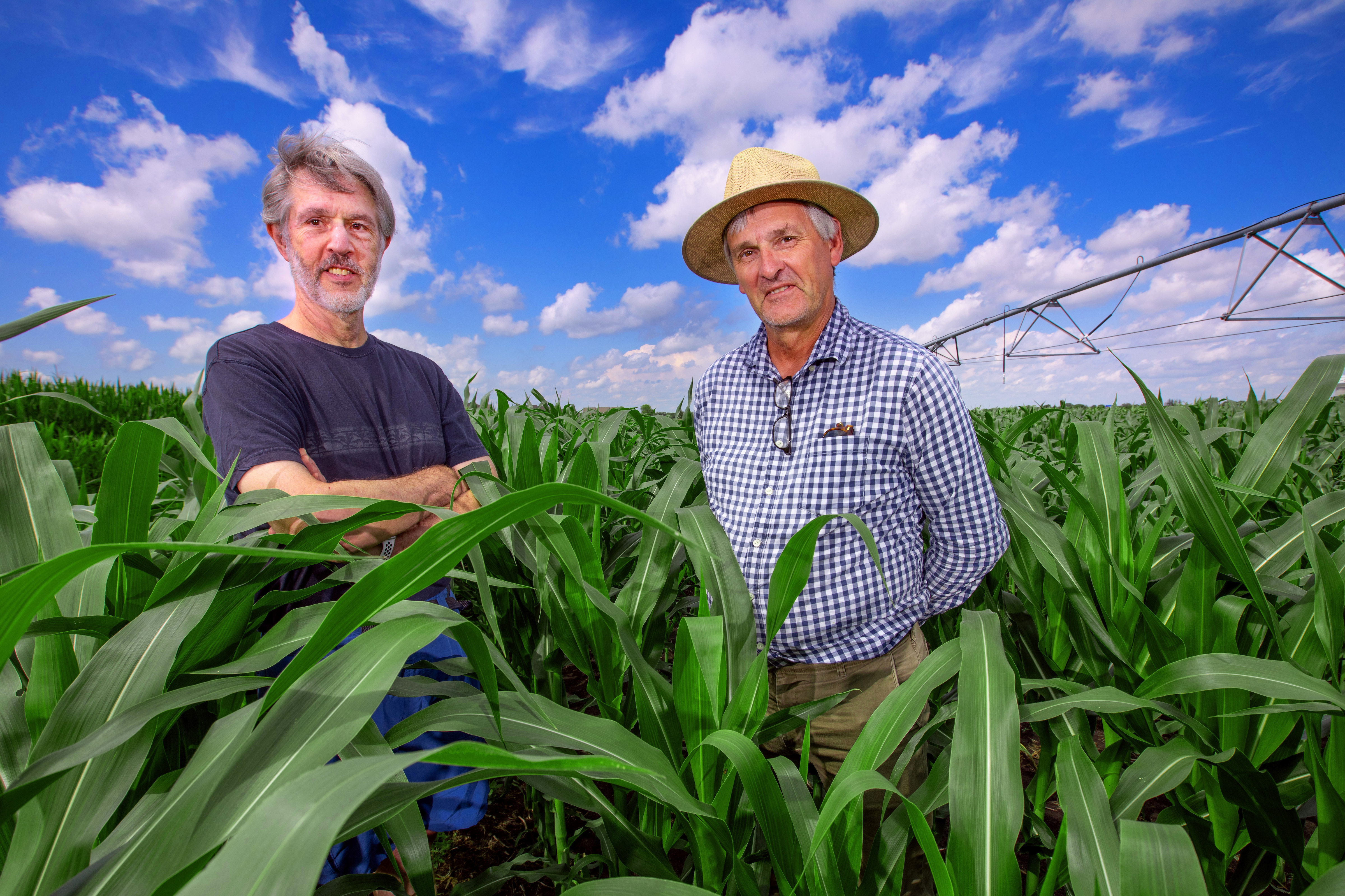
Alan Myers, professor of biochemistry, biophysics and molecular biology, on left, and Thomas Lübberstedt, K.J. Frey Chair in Agronomy, are both contributing to a federally funded research project that aims to use advanced breeding and genetic tools to improve the flavor and resilience of sweet corn. Photo by Christopher Gannon. Larger image.
AMES, Iowa — It’s hard to beat fresh sweet corn in the summer. Or is it? Two Iowa State University faculty are part of a major federal research project aimed at boosting sweet corn quality, using the same innovative genetic tools that have led to advancements in field corn.
“A lot of resources have gone into breeding field corn. But there has been far less effort in sweet corn,” said Thomas Lübberstedt, K.J. Frey Chair in Agronomy.
While sweet corn – fresh on the cob, frozen or canned – is one of the most popular vegetables among U.S. consumers, there are economic reasons why research has flowed to field corn used for livestock feed, food processing and manufacturing. The $800 million of sweet corn grown in the U.S. every year is about 1% of the country’s corn production. But Americans don’t eat enough veggies, and consumption of sweet corn, one of their favorites, has been trending down for decades. So the U.S. Department of Agriculture’s National Institute of Food and Agriculture has been funding a research project to improve sweet corn’s flavor and resilience.
After launching in 2018, the first few years of the eight-year, $15 million project were focused largely on establishing resources underpinning the work, including a panel of more than 600 genotyped sweet corn varieties for researchers to study, Lübberstedt said.
“That’s the project’s backbone,” he said. “Now we’re figuring out how to use the information.”
Perfecting the kernels
Research groups with collaborators from the University of Wisconsin, Washington State University and the University of Florida, the lead institution on the project, are working on varied aspects of sweet corn improvement. Alan Myers, a professor of biochemistry, biophysics and molecular biology at Iowa State, is exploring the genetic and biochemical processes that affect how carbohydrates are stored in corn kernels, hoping to heighten flavor and texture.
All sweet corn lines once owed their sugary taste to a genetic mutation which prevents the glucose that forms in kernels from crystallizing into a starchy insoluble polymer, Myers said. When its kernels are packed full of soluble glucose polymers, corn is sweet, juicy and chewy instead of hard and crunchy. In a second type of sweet corn developed about 20 years ago, the glucose in kernels doesn’t convert into polymers. That produces a sweet corn variety often used for commercial freezing and canning, but it doesn’t have the texture of traditional sweet corn.
“What we really want is to combine that favorable mouth feel with high sugar content,” Myers said.
Myers’ team is studying what enzymes affect polymer architecture in corn kernels, using tools such as CRIPSR gene editing to test adjustments. While improving quality with an optimal balance between starch and glucose is the primary goal, charting new methods for growing corn with a sugary snap has an important added benefit. The currently narrow genetic basis for sweet corn leaves the vegetable susceptible to new pest and disease threats.
“Finding different changes in the biochemical process to produce sweet corn would secure the crop against future challenges. We may never need to deal with that, but we want to be prepared,” Myers said.
Speeding up breeding
Lübberstedt’s group is working on refining doubled haploid technology to make the breeding method more common in sweet corn. An industry standard for producing commercial field corn seed, doubled haploid breeding shortens the process for developing inbred lines of hybrid corn from seven generations to two – saving years of time.
The process begins by creating haploids, a version of a plant with only half of its usual DNA code, by pollinating a donor with an inducer plant predisposed to produce haploids. The portion of offspring that are haploids, up to 15%, are then artificially treated early in their growing process to double their chromosomes, restoring an ability to reproduce. That creates a genetically pure plant that can be bred to create consistent hybrid seed.
The doubled haploid method is especially promising for seeking genetic gains in sweet corn, as many of the desirable traits – better taste, longer shelf life, disease and insect resistance – can be linked to individual genes. In contrast, field corn breeding more often looks to increase yield, an outcome impacted by numerous genes and other factors, Lübberstedt said.
“In sweet corn, there is usually a small number of specific genes you want to preserve, and you can do it with much less effort with doubled haploid breeding,” he said.
Lübberstedt’s group aims to make the method easier to use. One potential improvement is an inducer plant that creates haploids that can be identified by their oil content, automating a kernel-screening process typically done by hand based on haploids’ intentionally modified color. They also are looking at sweet corn varieties with a tendency to spontaneously double, which could eliminate the need to chemically treat young plants to create doubled haploids.
The project is expected to continue until 2025, but researchers’ work could find its way to consumers’ plates before then, Lübberstedt said.
“It’s possible that over the next few years what we’re developing will be incorporated into new varieties of sweet corn,” he said.







